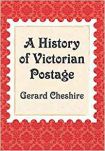A History of Victorian Postage by Gerard Cheshire
Although we think of postage and the sending of letters as a specifically Victorian innovation, its roots go far deeper than that. This book, which surveys a much broader time frame than the title might suggest, presents an admirably concise picture of their development.
| A History of Victorian Postage by Gerard Cheshire | |
|
| |
| Category: History | |
| Reviewer: John Van der Kiste | |
| Summary: Postage is often considered a specifically Victorian innovation, but its roots go back much deeper than that. This book traces its origins from the sixteenth century up to the 1840s and beyond, although despite what the title says not the entire Victorian era, with a very concise account of its development as a government service, early design and franking machinery. | |
| Buy? Yes | Borrow? Yes |
| Pages: 96 | Date: July 2017 |
| Publisher: Amberley | |
| ISBN: 978-1445664378 | |
|
| |
For those of us who thought it all started with the 'Penny Black' in May 1840, it is something of a revelation to learn that an organized postal service – although not as we understand it - was established in Britain over five centuries ago, during the Tudor age. The first Master of the Posts was Sir Bryan Tuke, secretary to Henry VIII. With increased literacy, letter writing and posting gradually became more widespread. Pioneers in France, Sardinia, Greece and Sweden also developed their own systems from the seventeenth century onwards, although all were doomed to eventual failure. The one which lasted was that propounded from 1837 onwards by James Chalmers and the man who took most if not all the credit, Sir Rowland Hill.
For three years the wheels of the official government think-tank ground on and on, and the Treasury ran a competition inviting members of the public to submit designs for the first adhesive postage stamp, as part of the envisaged uniform postal reform. Several of them are illustrated, although as the author makes clear, the real 'competition' was between Hill and The House of Lords, rather than a serious effort to prevail upon budding artists and designers to produce anything which would be given serious consideration. How the Penny Black and Twopenny Blue patterns were conceived and produced, with due regard for expense and anti-counterfeiting measures, is a convoluted and fascinating story in itself. The idea soon caught on in New York and elsewhere, and by 1861 the first published stamp catalogue revealed the existence of over 1,080 different specimens worldwide.
If you are looking for a full history of British postage or of stamp design up to the year 1901, you will not find it here. You will however have a very thoroughly researched account of how the business of sending letters through the post developed, with short chapters on the development of perforation and perfins (minute punched holes across stamps purchased for use in government offices, designed to prevent theft), the Maltese cross and other cancellations or postmarks from the early era, and early franking machines. There are illustrations on almost every page of early stamps and the labels they replaced, relevant government documents, and portraits of the leading figures involved. Several pages are devoted to the Mulready envelope, which was introduced at the same time but never became popular and was soon discontinued.
If you have ever wondered how we arrived at the familiar first or second class stamps and Christmas issues we use these days – and even receive, although less often than formerly thanks to the ubiquitous not to say boring franking machine (and the e-mail, of course) – then this provides us with a very thorough account of where it all began.
For a more general view of designs from 1840 to the present, we also recommend First Class: A History of Britain in 36 Postage Stamps by Chris West, and the time-honoured philatelist's evergreen bible on the whole subject, Stanley Gibbons Stamp Catalogue 2013: Commonwealth and Empire Stamps 1840 - 1970 by Hugh Jefferies.
Please share on: ![]() Facebook,
Facebook, ![]() Twitter and
Twitter and
![]() Instagram
Instagram
![]() You can read more book reviews or buy A History of Victorian Postage by Gerard Cheshire at Amazon.co.uk Amazon currently charges £2.99 for standard delivery for orders under £20, over which delivery is free.
You can read more book reviews or buy A History of Victorian Postage by Gerard Cheshire at Amazon.co.uk Amazon currently charges £2.99 for standard delivery for orders under £20, over which delivery is free.
![]() You can read more book reviews or buy A History of Victorian Postage by Gerard Cheshire at Amazon.com.
You can read more book reviews or buy A History of Victorian Postage by Gerard Cheshire at Amazon.com.
Comments
Like to comment on this review?
Just send us an email and we'll put the best up on the site.

